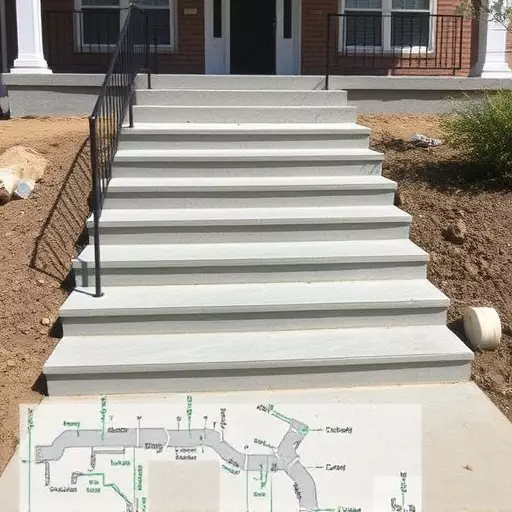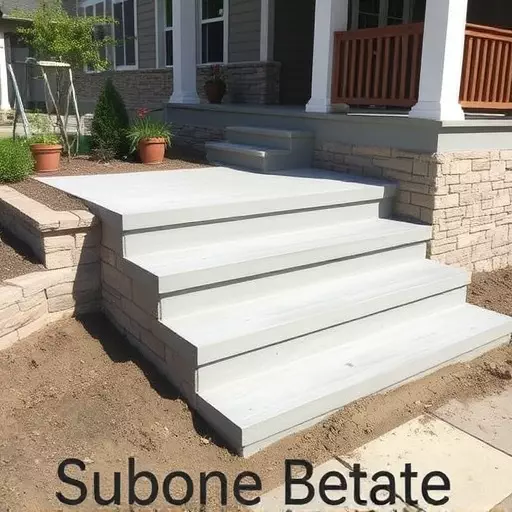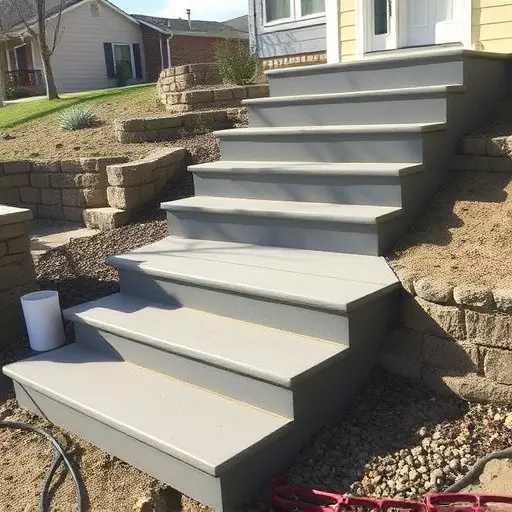Creating durable concrete steps in Toledo requires considering local climate, foot traffic, and structural needs. Residential steps focus on comfort, with various designs blending function and aesthetics, while commercial spaces demand robust structures to handle high volumes and potential heavier loads. The construction process involves preparing foundations, pouring concrete, reinforcing with steel bars, and finishing with textures or coatings. Key considerations include proper drainage through slopes or gaps, meticulous planning, accurate measurements, and skilled craftsmanship for structural integrity and desired style. Safety features like handrails and slip-resistant surfaces are crucial for both residential and commercial steps, adhering to building codes and regular inspections. Regular maintenance including cleaning, sealing, and repairing cracks extends the lifespan of concrete steps in Toledo's diverse outdoor conditions.
“Elevate your outdoor spaces with a robust and stylish concrete step construction process tailored for Toledo’s diverse environments. Whether enhancing residential or commercial settings, this guide offers concrete steps from understanding essential requirements to the final finishing touches. Learn about site evaluations, material selection, safety measures, code compliance, and maintenance tips to ensure the longevity of your outdoor concrete structures. Discover how to create safe, durable residential and commercial concrete steps for Toledo’s vibrant landscape.”
- Understanding Concrete Step Requirements for Outdoor Spaces
- Choosing the Right Design and Style for Residential and Commercial Settings
- Preparations: Site Evaluation and Material Selection
- Construction Process: From Foundation to Finishing Touches
- Safety Measures and Code Compliance for Concrete Steps
- Maintenance Tips to Ensure Longevity of Outdoor Concrete Structures
Understanding Concrete Step Requirements for Outdoor Spaces

Creating sturdy and safe concrete steps for outdoor spaces involves a meticulous understanding of the local climate, foot traffic, and structural requirements. The concrete step construction process varies slightly between residential and commercial projects. In Toledo and other areas, builders must adhere to specific guidelines to ensure safety and longevity.
For residential properties, steps should be designed with comfort in mind, considering the average height of adults and children. Commercial spaces may require more robust structures to accommodate higher volumes of foot traffic, frequent use, and potentially heavier loads. Regardless of the setting, proper drainage is crucial to prevent water damage and erosion, often incorporated into the step design through slopes, gaps, or grooves. The concrete step construction process involves preparing the foundation, pouring the concrete, reinforcing with steel bars (rebar), and finishing with a chosen texture or coating for durability and aesthetic appeal.
Choosing the Right Design and Style for Residential and Commercial Settings

When considering concrete steps for outdoor use, whether for residential or commercial settings, selecting the right design and style is paramount. For residential properties, a range of options offers both functionality and aesthetic appeal. From simple, straight designs to more elaborate styles with decorative elements, these steps can enhance the overall look and accessibility of your home’s entrance. Incorporating features like tapered edges, built-in lighting, or custom patterns allows for personalized touches that reflect individual style.
In commercial settings, concrete step construction in Toledo plays a crucial role in creating welcoming and accessible entrances. Design choices often focus on durability, safety, and visual impact to make a strong first impression. Sturdy, slip-resistant surfaces, along with well-planned lighting strategies, ensure safe navigation for all visitors. Additionally, incorporating modern designs or unique shapes can add character to public spaces, making them more inviting and memorable. The construction process involves careful planning, precise measurements, and expert craftsmanship to deliver the desired style while meeting structural requirements.
Preparations: Site Evaluation and Material Selection

Before starting the concrete step construction process in Toledo, whether for residential or commercial purposes, thorough preparations are essential. The first step is conducting a site evaluation to assess the landscape and determine the best location and design for your steps. Consider factors like slope, drainage, and proximity to entrances or exits. This analysis ensures that your concrete steps not only look aesthetically pleasing but also function safely and efficiently.
Material selection plays a crucial role in the durability and longevity of the final product. Concrete is a popular choice due to its strength and versatility. For outdoor use, opt for high-quality concrete mix designed for withstanding varying weather conditions. Reinforcement with steel bars or mesh can enhance structural integrity, especially for commercial concrete step construction where heavy traffic is expected. Additionally, selecting appropriate finishes like seamless molds or decorative patterns can enhance both functionality and visual appeal.
Construction Process: From Foundation to Finishing Touches

The construction process for both residential and commercial concrete steps in Toledo involves several meticulous stages. It begins with a solid foundation, ensuring stability and longevity. This typically includes excavating and preparing the site, installing steel reinforcing bars, and pouring a concrete base. For residential properties, steps are often designed to complement the existing architecture, utilizing different shapes, sizes, and styles such as straight, L-shaped, or curved. Commercial spaces may require steeper slopes and larger dimensions to accommodate higher foot traffic.
As the project progresses, skilled masons apply layers of concrete for treads and risers, shaping them according to the desired design. This intricate work demands precision to ensure each step has the correct depth and height. Finishing touches include applying texture or color, setting handrails, and installing lighting for safety and aesthetic appeal. The end result is a set of robust, durable steps that can withstand heavy use, offering both functionality and an attractive exterior feature.
Safety Measures and Code Compliance for Concrete Steps

When constructing or installing concrete steps for outdoor use—whether for a residential or commercial property in Toledo—adhering to safety measures and code compliance is paramount. For residential settings, local building codes dictate step dimensions, rise heights, and tread depths to ensure safe navigation. Typically, residential concrete steps should have a uniform rise of 7-8 inches and a tread depth of at least 10-12 inches for adequate traction. Additionally, handrails are often required on both sides for extra security, especially in high-traffic areas or steep inclines.
For commercial projects, safety standards remain crucial but may involve more complex considerations. This includes managing traffic flow, incorporating slip-resistant surfaces, and integrating safety features such as lighting. Commercial concrete step construction in Toledo should also comply with American Society of Civil Engineers (ASCE) guidelines for load bearing capacity and durability. Regular inspections by relevant authorities are vital to ensure these structures meet the required safety standards, preventing accidents and potential legal issues.
Maintenance Tips to Ensure Longevity of Outdoor Concrete Structures

Proper maintenance is key to extending the lifespan of outdoor concrete structures, including residential concrete steps and commercial concrete step constructions in Toledo. Regular cleaning and sealing are essential to protect against stains, moisture, and extreme weather conditions that can weaken the material over time. It’s recommended to sweep and clean the steps frequently to remove dirt, leaves, and other debris, preventing surface damage and costly repairs.
A good sealer applied annually will create a protective barrier, enhancing the concrete’s durability. This is especially important in areas prone to harsh winters or frequent rainfall. Additionally, repairing any cracks or chips promptly can prevent further damage and water penetration, which could lead to structural issues. Regular maintenance not only preserves the aesthetics of these structures but also ensures they remain safe and stable for years to come.


